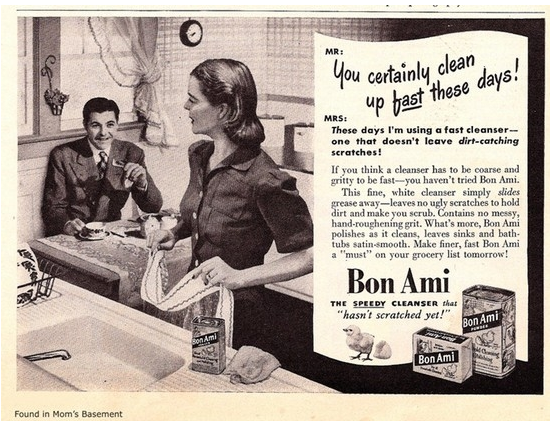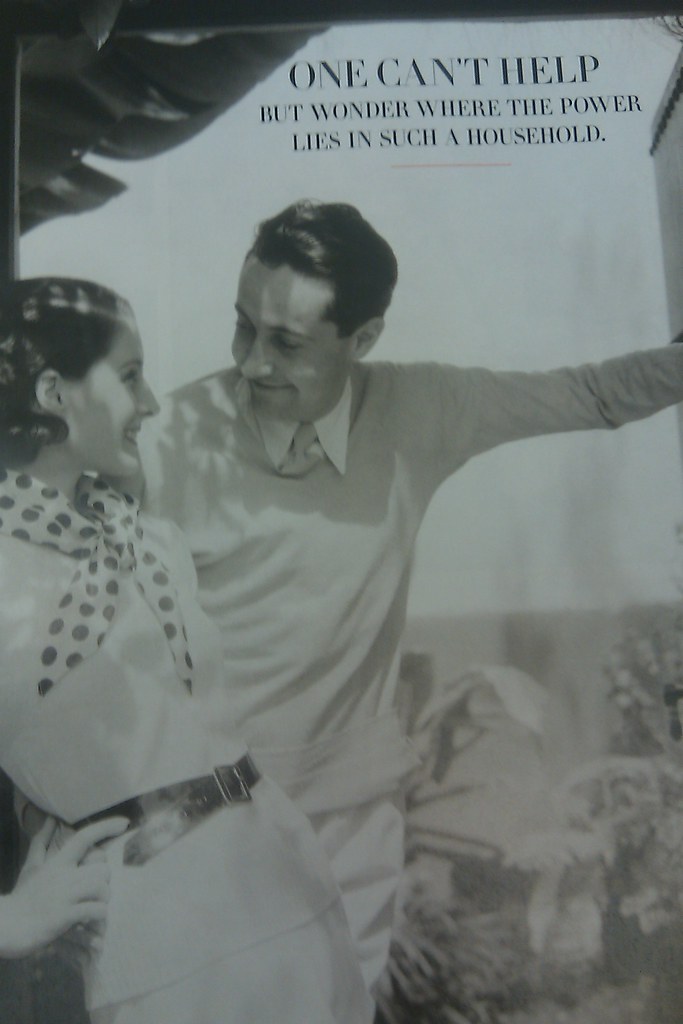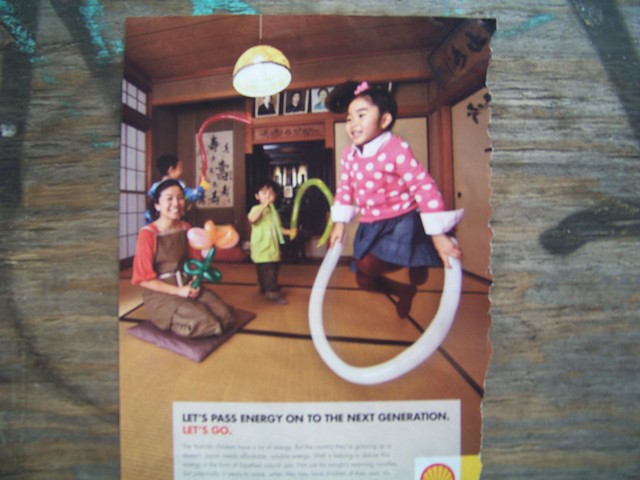
This old print ad from the 1950s depicts that idea of “home” as a space that is made into place by the addition of a nuclear family and the presence of a housewife who is seen as in her element there. If we exclude the dialogue between the husband and wife, and are left only examining the picture, we are left with the idea that home in a place for women (mothers, wives) to engage in place-making activities by constantly keeping the home clean which, inevitably, makes her husband very happy.


These two print ads from the 1960s explicitly show that a functioning “home” in middle-class, white suburbia was dependent upon the housewife’s role as maid as well as wife. The idea is that the role of the woman was to work tirelessly to make a home place for the rest of her family.
The final print media artifact I found takes a different look at the gender rules of the post-war home.

This print from Vanity Fair shows an old Hollywood glamour couple with the simple tagline, “One can’t help but wonder where the power lies in such a relationship.” This is a challenge to the specific roles of men and women in this time period. Putting the man and the woman on an equal playing field generates a sort of shock value that confuses some people who are used to the idea of the 1950s home wherein men have the most power, and women are delegated to tasks of housework.
As discussed, these print ads provide a specific meaning of home revolving around the nuclear family and the role of the wife. In Domosh and Seager’s chapter on home, the authors state that (through looking at such advertisements of women in these roles) these images of women rely on home “as the basis of definition.” In other words, home is essential to the identity of the women in these ads.
The problem with these depictions of home is that, while they may be the perfect picture of the “American Dream,” they are only imaginable to a small majority of people, those people being middle-class, white single-families in the suburbs. This largely excludes all minorities, any family making less than upper-middle class income, and any family unit or home that chooses an alternative lifestyle. This reminds of Betty Friedan’s “A Problem with No Name,” in the Feminine Mystique, about the woes of the middle-class housewife in the face of oppression and bell hooks’ resulting critique about how this ignores the realities of working women’s lives, who may have a completely different understanding of what home means.
Notions of "home" have changed a great deal from those beginnings. The stereotypical "traditional" family has been brought into the 21st century. Adult children are choosing to stay home with mom and dad. Even some of those who have left have returned home due to layoffs caused by The Great Recession.
Young people are not the only ones redefining "home." Oldsters are living longer and choosing not to give up their independence. Whether living in preplanned retirement communities or simply looking for roommates a la Oscar and Felix, today's retirees (don't call them "elderly") are continuing to live active lives.
Interestingly, conservative notions of the "traditional" family are most likely to be seen in less developed countries or poorer communities. Grandmother might move in after grandpa dies. Cousins and uncles might live next door or just down the street. More and more people are reinterpreting the meaning of the space we call "home." The media is catching on and updating how it portrays these new realities, whether it's Paul Newman in a boarding house or two nerdy scientists dealing with 30-something issues in Pasadena, the notion of home evolves as we do.
These three advertisements were all taken from different magazines. One being from National Graphic, another from Wired and a final from Life, made for a diverse selection.
 It is evident in all of them the different ways families or individuals can act at their home. There are different demographics as well as physical locations represented as well. Some people use the place of home for work and are able to incorporate their children into their daily life more than most. Although the work at home parent is gaining in popularity, a majority of adults still leave their home for work everyday. This makes for an interesting difference in a parents home and work life. As we discussed in class, the readings explained the different ways people view their home and how they act in it.
It is evident in all of them the different ways families or individuals can act at their home. There are different demographics as well as physical locations represented as well. Some people use the place of home for work and are able to incorporate their children into their daily life more than most. Although the work at home parent is gaining in popularity, a majority of adults still leave their home for work everyday. This makes for an interesting difference in a parents home and work life. As we discussed in class, the readings explained the different ways people view their home and how they act in it.  The three magazine ads accurately demonstrate the concept Gill Valentine explained about how people use home spatially and for personal fulfillment. The article "Putting Women in Place" is reference-able as well. The movement for women to have equal rights at home and in the work place is well documented in these ads. Magazines have long been a way of reaching a large viewing audience for advertisers. The three here are from rather different magazines but can all be tied together as a way of representing the way home and families have changed.
The three magazine ads accurately demonstrate the concept Gill Valentine explained about how people use home spatially and for personal fulfillment. The article "Putting Women in Place" is reference-able as well. The movement for women to have equal rights at home and in the work place is well documented in these ads. Magazines have long been a way of reaching a large viewing audience for advertisers. The three here are from rather different magazines but can all be tied together as a way of representing the way home and families have changed.Here are the links for our presentation to the AdCouncil culminating in a PDF file featuring our "family" campaign poster.
http://www.brianwoods.com/traditional.pptx
http://www.brianwoods.com/poster.pdf
By Taylor, Robin, Kelly, Kyle and me
No comments:
Post a Comment